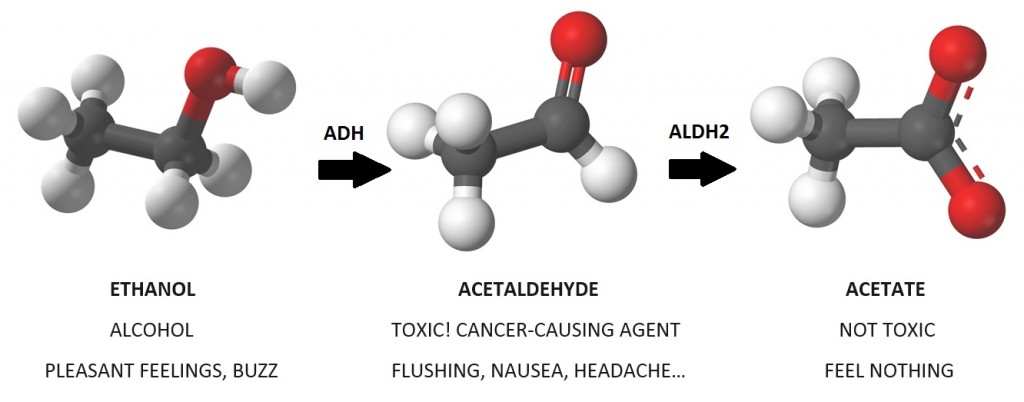Have you ever gone out to the bar or had a couple of drinks with friends of East Asian heritage (Chinese, Japanese, and Korean)? If so, you would have probably noticed that at least one of their faces turned red after only a few sips of alcohol. This is called the “Asian Glow”. As the name suggests, it refers to the common reaction of Asians turning red after drinking alcohol.
According to U.S. Department of Health & Human Services, our body breaks down alcohol in two steps, facilitated by two enzymes that speed up the break down process. The enzyme alcohol dehydrogenase (ADH) converts alcohol into a toxic intermediate called acetaldehyde (C2H4O), then the second enzyme aldehyde dehydrogenase (ALDH2) turns it into acetate (CH3CO-2) and releases the toxic compound out of the body.

Breakdown of Alcohol in Two Steps | Credits: ethanol, acetaldehyde, acetate molecules from Wikimedia | Edit: Even Zheng
Unfortunately, about 80% of all East Asians are born with overactive ADH in their stomach and liver, breaking down alcohol up to 100 times faster into the toxic acetaldehyde. In addition, about 50% of East Asian have a deficiency in ALDH2 enzymes, which means it takes much longer for the body to clean out the residues of alcohol. Simply put, their body skips right past the pleasant effect of alcohol and experiences body rash, nausea, dizziness, and all the “hangover symptoms” much faster. Now we know who to blame, it’s all because of genes!
I remember a time I was at my friend’s place for a small gathering. It was only half an hour into the chitchat when my friend pointed at me and said, “Your face looks like a stop sign!” followed by everyone’s laughter. At that time, I literally had half a can of beer. If anybody can relate, someone has probably also told you to practice and increase your tolerance level, but you might want to give that a second thought.
What most people don’t know is that the toxic acetaldehyde is actually a cancer-causing agent. An article published by The New York Times revealed that researchers believe the condition of turning red after drinking alcohol may link to increased risk of throat, stomach, and esophagus cancer, which are some of the most deadly types of cancer. This is especially dangerous for people who have developed a high tolerance to acetaldehyde and became heavy drinkers.
A Time Magazine article suggested that the hereditary trait may have evolved in the ancient Chinese population as a survival strategy to allow people to drink alcohol made from fermented rice, while protecting them against alcoholism. Regardless of its credibility, there is indeed a lower rate of alcoholism among people with the deficiency, for obvious reasons. Before we find any way to replace the inactive enzyme or develop safe medications, it is the best to just avoid drinking altogether. It might make your parties a little “lame” on Friday nights, but on the bright side, you now have a good excuse to tell your friends when they want to go out for a drink right before your exam.
Here is a video to help you understand the metabolism of alcohol: 
Credit: Science of Nutrition
-Even Zheng

